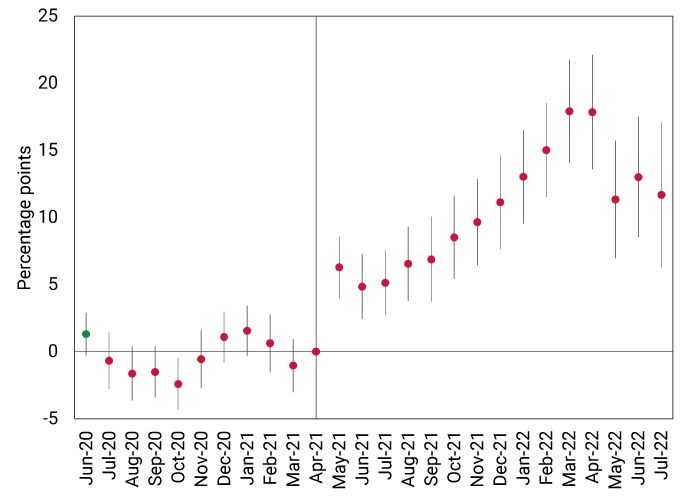Since the second half of 2021, food prices in Colombia grew on average 12 percentage points more than in the other OECD countries and seven percentage points more than in the rest of Latin America. A document in the recent Monetary Policy Report, prepared by Edgar Caicedo, Adolfo Cobo, Margarita Gáfaro, and Alejandra González, researchers at Banco de la República (the Central Bank of Colombia), shows that this difference in food inflation between Colombia and other countries emerges in May 2021. This moment coincides precisely with the beginning of the road blockades due to the National Strike, and is not explained by differences between countries regarding the currency devaluation and rainfall shocks, or by the imports of inputs and exports of food in Colombia. The document also discusses how the road blockades during the strike affected agricultural production in the country, causing effects that still persist in some sectors.
To illustrate the results of the study, Figure 1 shows the evolution of the differences in annual food inflation between Colombia and the average of 44 OECD countries and Latin America. Until April 2021 these price differences were close to 2 percentage points and remained constant over time. As can be seen in the graph, in May 2021, food prices in Colombia grew 6 percentage points more than in the rest of the countries. This price increase in Colombia, relative to other countries, is not only maintained, but continues to grow until March 2022. Thus, between May 2021 and July 2022, annual food inflation in Colombia grew by an average of 9 percentage points more than in the rest of the countries in the sample.
Figure 1. Conditional difference in food prices in Colombia and international averages.

The econometric methodology used to calculate these differences in price inflation between Colombia and other countries discounts the effect of factors such as currency depreciation and rainfall shocks. It also ignores the effect of international price shocks depending on the countries' dependence on imports and exports of raw materials and food. This implies that the increases in food inflation in Colombia, compared to other countries presented in the graph, are not explained by these factors. The coincidence between the timing of this discrepancy in food inflation and the beginning of the National Strike suggests that these price increases could be associated with persistent effects of the strike on food production in the country.
During the National Strike, which began on 28 April 2021 and lasted approximately two months, there were road blockades that hindered food supply in the main cities and access to raw materials from farms, particularly in the southwest of the country. This generated immediate pressure on prices, causing shortages in the cities. It also generated persistent pressures on production by affecting the growth cycles of animals on livestock farms and producers' cash flows for the replanting of short-season crops.
Egg production was one of the most affected by this phenomenon. Between January 2020 and April 2021, egg production grew at an average annual rate of 12.0%. From May 2021, this growth dropped to an average of -1.0%, while prices showed an average annual growth of 23.0%. The lack of feed for poultry in farms in the southwest, which produces about 30.0% of the total in the country, affected the development of breeding and laying birds, with effects on production that, according to sector informants, would take up to two years to dissipate. All this occurred at a time of strong demand and high input costs, which could have exacerbated the effects of these drops in production on prices.
The statistical techniques used in the study do not allow to completely rule out the possibility that other factors specific to the Colombian economy explain part of the price differences between Colombia and other countries. However, the impact of road blockades on food production and distribution cycles suggests that strike is a relevant factor to explain them.

































































